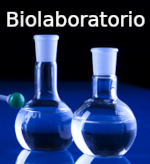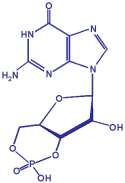
© Blauplanet.com
Other sections:





Cyclic GMP
Site
Created by Dr. Luis Agulló (last update on 28-12-2007)
Introducing Nitric Oxide
Who is Nitric Oxide?
Nitric oxide (NO) is a hydrophobic diatomic gas that is synthesized in different cells of the organism and that has a crucial role as a signaling molecule. The signal transduction systems in which nitric oxide participates are especially important in the brain and in the cardiovascular system.
The Discovery of Nitric Oxide
How synthesis of cyclic GMP (cGMP) is modulated by a specific enzyme (the cytosolic isoenzyme of guanylyl cyclase or soluble guanylyl cyclase, sGC) was known as a consequence of the convergence of two very different lines of research.
On the one hand, the group of Murad demonstrated in 1978 that the vasodilatory effects of nitroglycerine and other nitrates (that had been used for decades without knowing their mechanism of action) were mediated by a common degradation product that was very unstable, nitric oxide or NO. This compound was able to induced the activation of soluble guanylyl cyclase in the smooth muscle cells of blood vessels.
On the other hand, Furchgott and Zawadzki in 1980 observed that relaxation of blood vessels by acetylcholine required an intact endothelial layer. A compound released by endothelial cells and acting on smooth muscle cells was hypothetyzed and named endothelial derived relaxation factor (EDRF).
During the following years it appeared that there were chemical similarities between nitric oxide and EDRF. Besides, both compounds exerted vasodilation by means of cyclic GMP synthesis. Finally, the groups of Furchgott and Ignarro independently proposed in 1986 that EDRF was really nitric oxide. Soon, the group of Moncada (1987) obtained the first results supporting that proposal. Moreover, they demonstrated that endothelial cells produced nitric oxide in sufficient amounts to explain the relaxation observed. So, the previous proposal was confirmed and, at the end, one of the pathways of cyclic GMP synthesis uncovered.
The synthetic reaction
Nitric oxide is synthetized by nitric oxide synthases (NOSs). Three isoforms of this enzyme can be distinguished: NOS1 (also named as neuronal NOS, nNOS, or NOS I), NOS2 (inducible NOS, iNOS, or NOS II), and finally NOS3 (endothelial NOS, eNOS, or NOS III). All these subtypes use L-arginine, oxygen, and NADPH as substrates and produce nitric oxide, L-citrulline, and NADP+. Besides, FMN, FAD, tetrahydrobiopterin, heme, and Ca2+/calmodulin are needed as cofactors. Although, NOS1 was initially found in the brain, NOS2 in macrophages and NOS3 in the endothelium, they have later found in many other cells of the organism.
Related Web Sites
Nitric Oxide (NO) [good introduction to NO; Kimball's Biology Pages]
Nitric Oxide [concise and clear; Mathews]
The Nobel Prize in Physiology or Medicine 1998 [excellent explanation of NO discovery with good figures; The Nobel Foundation]


Author: Dr. Luis Agulló (luis.agullo [at] lagullo.com).
Edited by Blauplanet.com, Cerdanyola del Vallès, Barcelona, Spain.
Webmaster: info [at] blauplanet.com. Conditions of use.